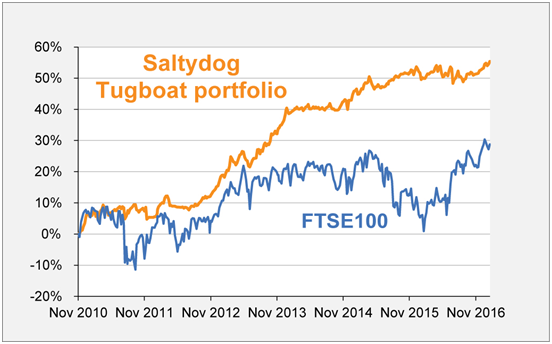Dec
2023
Investing Basics: The secret of successful trend investing
DIY Investor
4 December 2023
Trend investing – also known as ‘trend following’ or ‘momentum investing’- is a proven method of making money in the stock market, and goes back over one hundred years. It is fascinating how trend investors in very different times, and places, have come up with uncannily similar rules for making good profits.
Let`s look at five of these rules for trend investing success.
- The vital importance of market sector recognition and a supply of accurate up-to-date performance data.
- Don`t always be invested in the market. In times of market uncertainty, cash is a good home for your money.
- Test the validity of a new trend with a small investment first.
- Once a trend is established for a fund or sector, it is more likely to continue in that direction than to move against the trend. In other words, the value of the fund gains a certain ‘momentum’.
- After a steady rise the fund, or sector, levels off and turns down with only occasional rallies; it is obvious that the line of least resistance has been changed from upwards to downwards. There is no need for explanations, now is the time to sell.
This is perhaps the moment to take a quick flashback to the origins of the Saltydog system of investing.
A story of foolishness and what not to do with £150,000
In 1975, I set up a flat-pack furniture manufacturing business and ten years later, in 1985, I successfully sold it.
Using some of the proceeds from the sale I invested £150,000 into two Investment Bonds (equivalent of £450,000 in today’s money). I purchased these two bonds via an Independent Financial Advisor as the investment company concerned did not deal directly with the public.
Like so many people, I had been sold the illusion that financial advisors actually ‘advise’, that wealth managers actually ‘manage’, and that the financial industry has individual investor’s interest at heart. This was foolish of me.
‘I had been sold the illusion that financial advisors actually ‘advise’’
Stupidly, I only began to take an active interest in the performance of the two bonds 15 years later. I had two unpleasant surprises.
Firstly, there had been little capital growth and secondly my money was still in the same market sectors as at the outset! It had just been sitting there, forgotten, throughout the fifteen years, regardless of the dramatic changes in the investment landscape.
During this period I had built another successful furniture business, but this particular investment had withered on the branch.
Enough is enough; it was time to take control myself, and thus began the road that led to the Saltydog trend investing system.
A naive idea
Crucially, I didn’t come to the data with a pre-existing strategy in mind. At the time, I wasn’t a value investor, a contrarian investor, a passive investor, a trend investor or anything else.
Essentially, all I had was an open mind and a talent for analysing numbers and one seemingly naive idea, and that was in order to make money you need to be in the market when it is going up and out when it is going down.
So how to achieve that? I pored over numbers for about 70 individual funds, and after a number of months I started to see patterns emerging.
Wisdom from one of the world’s best traders
The first of the patterns I noticed was that some funds would move together in the same direction, up or down, as if in tandem. After observing this phenomenon for a while, researching, and making enquiries, I worked out that these funds were in the same sector. Stated like this, it hardly seems like a revelation.
In fact it seems blatantly obvious, but I was starting with individual fund data and nothing else. So to me it was a real discovery. If you are thinking, ‘So what?’, then just consider this piece of wisdom from one of the richest men in the U.S.A in 1929 – the renowned trader and investor, Jesse Livermore:
‘The most intelligent way to get one’s mind attuned to market conditions and to be successful is to make a deep study of Industry Groups in order to distinguish the good from the bad.
Get into those which are in a promising position, and get out of those Industry Groups which are not.
On Wall Street, people very often fail to see the thing that is right in front of them. I cannot emphasise too strongly the importance of examining Industry groups.’
If you simply replace the term ‘Industry Groups’ with the term ‘Fund Sector’, this could be an instruction from the current Saltydog member’s handbook.
Why buy-and-hold investing seems silly
I cannot see the sense in staying in the market all the time. Why would anyone stay in when it is heading down? Do they want to lose money? It seems pointlessly fatalistic to me.
‘I liken trend investing to going to a horse race and being able to switch to the leading horse as the race progresses’
If you are prepared to be active, and are using accurate numbers and information, it just seems like common sense to be mobile. Especially in this day and age when moving in and out of funds can be transacted for very little money.
At the same time, there is a more subtle meaning to this rule, and that is … don’t invest when you cannot see a clear trend. Or conversely, only invest when you are confident that a trend has emerged.
I liken trend investing to going to a horse race and being able to switch to the leading horse as the race progresses. You are in the best position throughout and you will win in the end.
Take small steps quickly to win
I started the Saltydog system with a fundamentally conservative, risk-averse approach. I felt that the worst thing you can do is to lose money.
Through a process of trial and error I worked out one practical guideline to help with protecting my investment.
That was, as an active investor you do not need to commit all your money at once, or take it all out at once. It is not a black and white, either/or situation.
You can test the market by placing small sums and see how they pan out, then if it goes against you, reduce your holding. This ‘softly softly’ approach greatly minimises the risk. Surprise, surprise, that is exactly what the great Jesse Livermore also advised. He said:
‘It is the change in the major trend that hurts most investors. They simply get caught investing in the wrong direction, on the wrong side of the market. To determine if I was right in my appraisal, I used small position probes, placed small orders to test the correctness of my judgement.’
Follow in the footsteps of Jesse Livermore
Now I am not claiming that the Saltydog system will turn you into the next Jesse Livermore. Whilst that might be nice, as at one point he was worth over $1.3billion, he must have been a strange man. He married four times and ended his life by committing suicide.
Obviously a man of extremes! However, what I do claim is that we at Saltydog have devised algorithms to examine and interrogate the performance of the many thousands of funds available for investment.
The Investment Association sectors are plotted to show the relative performance between the sectors, and then presented in graph form for easy recognition. The best performing funds are then shown in a similar fashion, taking all the work away from the reader. This has expanded out of all recognition from what I was doing by long- hand in the early 2000s for the seventy or so funds that were available to me.
To prove the system had legs we invested £40k of our own money into a real demonstration portfolio in November 2010. It was called the ‘Tugboat’ and was designed to avoid the drops in the market and give a return of around 8% per annum. It is now a fraction below this target.
We launched a second demonstration portfolio in November 2013, the Ocean Liner, which is slightly more adventurous, and this is returning close to 10% per annum.
CONCLUSION
The average person with access to accurate information can make a good return on his money by trend investing, if he abides by a clear set of rules and is not greedy or over optimistic. He must be aware that sometimes the grass will appear greener on the other side because it has been fertilised by financial pundit’s utterances. So stick to the facts that the numbers reveal.
Saltydog Investor is the UK`s first fund performance data monthly subscription
newsletter which provides a weekly electronic fund performance data feed, aimed at the D.I.Y. investor. It provides listings of the top ten percentage of performing funds, sorted by sector and volatility, in an easy to understand, accessible format. Saltydog Investor is designed to encourage and enable lay investors to manage their own investments. www.saltydoginvestor.com
Come to the Saltydoginvestor partner page here
Commentary » Financial Education » Latest » Mutual funds Commentary » Mutual funds Latest » Take control of your finances commentary




Leave a Reply
You must be logged in to post a comment.